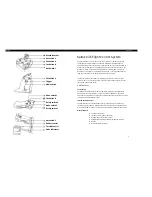
Yokogawa Electric Corporation - TC10-L - ENGINEERING MANUAL - PAG. 8
For more details see [15] o3.Ac parameter.
]
AL1 Group - Alarm 1 parameters
[19] AL1t - Alarm 1 type
Available:
Always.
Range:
nonE = Alarm not used;
LoAb = Absolute low alarm;
HiAb = Absolute high alarm;
LHAo = Absolute band alarm with alarm indication
out of the band;
LHAi = Absolute band alarm with alarm indication
inside the band;
SE.br = Sensor break;
LodE = Deviation low alarm (relative);
HidE = Deviation high alarm (relative);
LHdo = Relative band alarm with alarm indication
out of the band;
LHdi = Relative band alarm with alarm indication
inside the band.
Notes: 1.
The relative and deviation alarms are “relative” to
the operative set point value.
LoAb
OUT
AL1
AL1
PV
HAL1
time
HiAb
off
off
off
OUT
AL1
AL1
PV
HAL1
time
off
off
off
ON
ON
ON
ON
LHAo
PV
AL1H
HAL1
time
off
off
off
LHdo
OUT
AL1
AL1L
HAL1
PV
AL1H
SP
HAL1
time
OUT
AL1
-AL1L
HAL1
off
off
off
ON
ON
ON
ON
2.
The (SE.br) sensor break alarm will be ON when
the display shows
----
indication.
[20] Ab1 - Alarm 1 function
Available:
When [28] AL1t is different from “nonE”.
Range:
0 to 3 with the following rule:
+1 = Not active at power up;
+2 = Relative alarm not active at set point change.
Notes: 1.
The “not active at power up” selection allows to
inhibit the alarm function at instrument power up
The alarm will be automatically enabled when the
measured value reaches, for the fi rst time, the
alarm threshold ±hysteresis (in other words, when
the initial alarm condition disappears).
PWR ON
AL1
PV
time
off
off
Ab1 = +1
Ab1 = +0
off
off
ON
ON
ON
2.
A
relative alarm not active at set point change” is
an alarm that masks the alarm condition after a
set point change until process variable reaches
the alarm threshold ±hysteresis.
Sp2
Sp1
PV
time
Ab1 = +8
Ab1 = +0
ON
off
off
AL1
off
off
off
AL1
ON
ON
ON
ON
3.
The instrument does not store in EEPROM the
alarm status. For this reason, the alarm status
will be lost if a power down occurs.
[21] AL1L - For High and low alarms it is the low
limit of the AL1 threshold
- For band alarm it is low alarm threshold
Available:
When [19] AL1t is different from “nonE”.
Range:
From -1999 to [22] AL1H engineering units.
[22] AL1H - For High and low alarms, it is the high
limit of the AL1 threshold
- For band alarm, it is the high alarm
threshold
Available:
When [19] AL1t is different from “nonE”.
Range:
From [21] AL1L to 9999 engineering units.
[23] AL1- Alarm 1 threshold
Available:
When:
[19] AL1t = LoAb - Absolute low alarm;
[19] AL1t = HiAb - Absolute high alarm;
[19] AL1t = LodE - Deviation low alarm (relative);
[19] AL1t = HidE - Deviation high alarm (relative).
Range:
From [21] AL1L to [22] AL1H engineering units.
[24] HAL1 - Alarm 1 hysteresis
Available:
When [19] AL1t is different from “nonE”.
Range:
1 to 9999 engineering units.
Notes: 1.
The hysteresis value is the difference between
the Alarm threshold value and the point the Alarm
automatically resets.
2.
When the alarm threshold plus or minus the
hysteresis is out of input range, the instrument
will not be able to reset the alarm.
Example:
Input range 0 to 1000 (mBar).
–
Set point equal to 900 (mBar);
–
Deviation low alarm equal to 50 (mBar);
–
Hysteresis equal to 160 (mBar) the theoretical reset point is
900 - 50 + 160 = 1010 (mBar) but this value is out of range.
The reset can be made only by turning the instrument
OFF, removing the condition that generate the alarm and
then turn the instrument ON again;
–
All band alarms use the same hysteresis value for both
thresholds;
–
When the hysteresis of a band alarm is bigger than the
programmed band, the instrument will not be able to reset
the alarm.
Example:
Input range 0 to 500 (°C).
–
Set point equal to 250 (°C);
–
Relative band alarm;
–
Low threshold equal to 10 (°C);
–
High threshold equal to 10 (°C);
–
Hysteresis equal to 25 (°C).






































